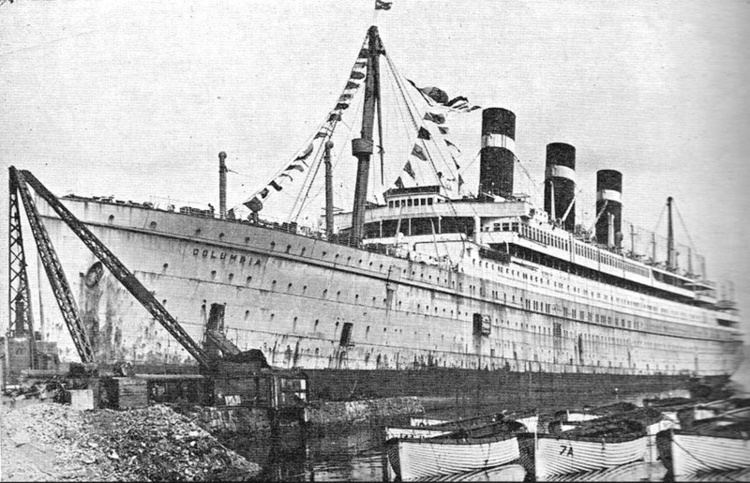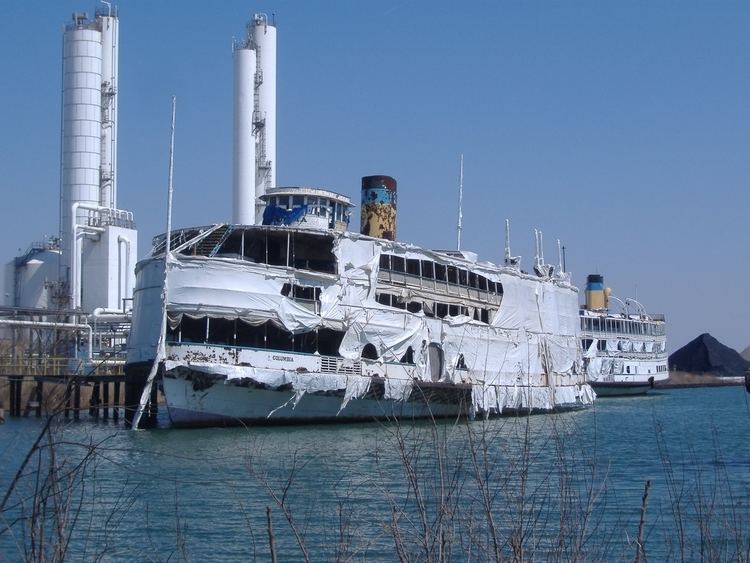Name Columbia Out of service 1991 Tonnage 968 (gross) 549 (net) Length 63 m Year built 1902 Added to NRHP 2 November 1979 | In service 1902 Status under restoration Beam 45 ft (14 m) Launched 1902 Builder Detroit Dry Dock Company Architect Frank E. Kirby | |
 | ||
Place built Detroit, Michigan, United States | ||
Restoration work continues on the ss columbia at silo city
SS Columbia is one of two remaining excursion steamships from the turn of the 20th century in existence, the second being her running mate, and sister ship SS Ste. Claire. Both were designed by Frank E. Kirby and Louis O. Keil. Columbia was listed on the National Register of Historic Places in 1979.
Contents
- Restoration work continues on the ss columbia at silo city
- Ss columbia 1880 1907 the lost light
- History
- Deterioration and restoration
- References

Ss columbia 1880 1907 the lost light
History

Columbia was constructed in Wyandotte, Michigan in 1902, and Ste. Claire was constructed in Toledo, Ohio in 1910. The naval architect Frank Kirby designed a new girder system for Columbia that allowed for the spans needed for a dance floor, thus Columbia was the first steamboat in the US with a proper ballroom. Columbia influenced the design of excursion steamers including Americana, Canadiana, Ste. Claire, Put-in-bay, Peter Stuyvesant, and Catalina throughout the US. Columbia and Ste. Claire were originally joined by a third, SS Britannia, built in 1906. During their heyday, Columbia and Ste. Claire sailed down the Detroit River from downtown Detroit to Bois Blanc Island, a Canadian island that was home to an amusement park built as a destination for the steamers. During the summer, the ship's triple decks would be filled with passengers enjoying the 90-minute, 18-mile (29 km) boat ride to the island. Both ships featured music and dancing, an arcade, and a snack bar. The ships became icons on the Detroit River and were greatly loved by the people of Detroit.

Columbia became the setting for an historic Civil Rights battle in 1945 when a young African American woman named Sara Elizabeth Ray joined her classmates for a celebratory graduation cruise aboard the ship. Officers of the Boblo Excursion company then approached Ray and told her she had to leave due to her race. When they threatened her with physical removal, she agreed to leave but not before throwing the proffered fare refund back at them and getting their names. Ray enlisted the help of the NAACP in filing a complaint against the line for illegal discrimination. The Boblo Excursion company claimed exemption from the Michigan statutes due to their routes traversing the Canada–US border thereby claiming that they were engaged in international commerce and were not subject to state regulations. Ray won in the local courts and then in state court and ultimately in the US Supreme court. This decision is viewed as being the first step towards Brown vs. Board of Education.
Deterioration and restoration

Due to competition from nearby Cedar Point, attendance at Boblo Island declined. In 1990, the company then operating Boblo Island said the steamers were too much to handle and were becoming a burden on the company's finances. The summer of 1991 was the last for Columbia and Ste. Claire. In 1993, Boblo Island was closed and sold to real estate developers. The ships were docked outside the Great Lakes Steel Company in Ecorse, Michigan where they sat unprotected from the harsh Michigan winters. They were auctioned in 1996 and by 2000, both steamers were showing deterioration with chipped paint, rotting wood, and holes in the decks.

In 2004 a team led by the Detroit Riverfront Conservancy had Columbia "shrink-wrapped" (in heavy plastic tarps) to reduce further deterioration while they considered purchase and restoration. However, in early 2006, given budgetary constraints they removed themselves from consideration. Later that year, with the assistance of National Trust for Historic Preservation Columbia was awarded to a New York-based non-profit group, "The S.S. Columbia Project", for restoration to active service as an educational, cultural, and Heritage tourism resource for use on the Hudson River.

The plan for the ship's restoration and re-use was based on the European model of maritime preservation where the ship's restoration is funded through a non profit capital campaign and then the ship's operations are funded through earned revenues. Plans for the restored ship included daily excursions from the west side of Manhattan to the communities of the Hudson Valley.
A partial restoration of both ships, Columbia and Ste. Clair, was made for the 2014 feature film Transformers: Age of Extinction.
In September 2014, Columbia was towed from Detroit to Toledo, Ohio for dry docking in preparation for moving to New York. In September 2015, it was moved to Buffalo, New York, where it is being prepared for an eventual move to the Hudson River.
